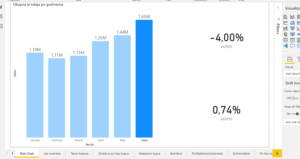Budget
Budgeting represents the most important segment of operational planning. In fact, the budgeting system plays a crucial role in ensuring that managers and employees achieve their goals related to business growth and cost management.
A budget is a financial expression of operational plans. Operational plans come from the sales, marketing, production, procurement, investment plan sectors, and all other operational plans to achieve strategic goals. The budgeting system involves creating a budget but also moderating and animating that budget so that once created, it becomes a tool for achieving those strategic goals. These goals can include sales growth, lower costs, changes in product assortment, changes in customer assortment, and the final goal of profit growth.
Participants in the budgeting system are numerous and can be divided into two groups based on their impact on the budget. The first group consists of budget moderators, who are responsible for ensuring the budget exists. In most cases, these are employees in the finance and controlling sectors. The second group includes all other employees responsible for providing so-called input data. Input data comprises the budget and comes from the individual operational plans of sales, marketing, production, procurement, human resources, administration managers, and others.
The budgeting process can be Top-down and Bottom-Up. Top-down budgeting involves cascading goals from the top down (from the top of the company to the individual employee). Bottom-Up budgeting involves planning from the bottom up (from the individual employee to the top of the company). The budgeting process is always a combination of the two principles and should never be one-sided.

Why is a budgeting system necessary?
Goals! Goals, definitely, as the shortest and most precise answer.
An efficient budgeting system enables the company to:
- Clearly communicate targets and expected results
- Make the best possible use of company resources
- Maintain a stable cash flow
- Provide a tool for tracking results from the highest management levels to operational team leaders
- Establish a system for early detection of inefficient resource use
- Create a system for early detection of market obstructions

Problems:
Each of the benefits of a budgeting system, when it does not exist, actually represents a problem that companies face. Here are some of them:
- The financial director and finance department are under constant pressure because they lack a clear picture of future cash inflows and outflows. This uncertainty translates to procurement, which cannot purchase goods or raw materials, further increasing pressure on sales. The entire organization functions without a plan!
- In the income statement, you see the achieved profit but do not notice the relaxation in terms of cash flow status.
- Achieved results are not comparable; in the case of both good and bad company results, management does not have a clear picture of what led to those outcomes.
- You realize too late that you have lost customers, assortment, or that you have paid too much or too little attention to certain market segments.
- Inefficient resource usage...
The role of AIM Institute
AIM Institute successfully works on designing the entire budgeting process. Whether there is no budgeting system or an existing budgeting system that does not satisfy your needs, AIM provides support in designing a perfectly optimal process using the best global practices.
Implementation segments:
- Employee involvement: Implementation always involves employees. On one hand, it focuses on training and developing budget moderators, while on the other hand, it communicates with all other employees to understand the budget as a tool for achieving goals.
- Designing procedures: During implementation, the design and establishment of procedures and behavioral patterns in the budgeting process are addressed.
- Software integration: Implementation includes software. The complexity of the software varies, and the choice of software exclusively depends on the company's needs.
